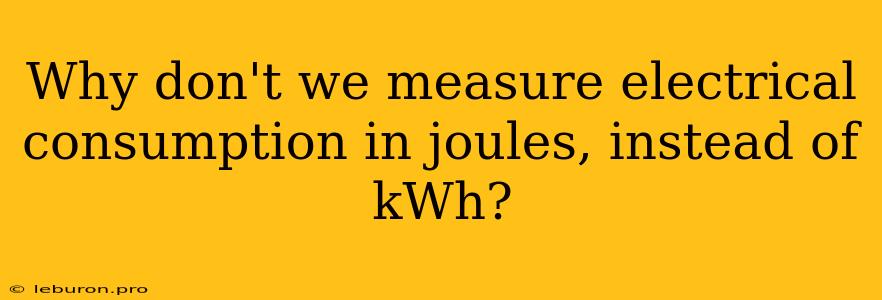The familiar kilowatt-hour (kWh) dominates our understanding of electrical consumption. However, the joule (J), the standard unit of energy in the International System of Units (SI), might seem like a more intuitive choice. Why then, do we rely on the kWh, especially when considering the joule's widespread use in other scientific fields? This article delves into the reasons behind this seemingly odd preference, exploring the historical context, practical considerations, and the advantages and disadvantages of each unit for measuring electrical consumption.
The Joule: A Fundamental Unit of Energy
The joule, named after the 19th-century physicist James Prescott Joule, is the SI unit of energy. It represents the amount of energy transferred when a force of one newton is applied over a distance of one meter. This simple definition makes the joule applicable across various scientific disciplines, from mechanics and thermodynamics to electricity and magnetism. For instance, a joule can represent the energy stored in a battery, the kinetic energy of a moving object, or the heat energy released in a chemical reaction.
Joules in Electrical Context
In the context of electricity, the joule represents the energy consumed by a device when it draws a current of one ampere for one second at a potential difference of one volt. This connection between joules and electrical quantities is rooted in the fundamental relationship between energy, power, and time. Power, measured in watts (W), is the rate at which energy is consumed. One watt is equivalent to one joule per second (1 W = 1 J/s). Therefore, the energy consumed in joules can be calculated by multiplying the power in watts by the time in seconds.
The Kilowatt-hour: A Practical Unit for Billing
While the joule serves as the fundamental unit of energy, the kilowatt-hour (kWh) has become the dominant unit for measuring electrical consumption, particularly in the context of billing. This preference stems from several practical considerations:
Scale and Convenience:
The joule, despite its scientific elegance, is often too small for everyday electrical energy usage. Household appliances, for example, typically consume energy in the range of thousands or even millions of joules. Using joules to express this consumption would lead to cumbersome numbers. The kilowatt-hour, on the other hand, provides a more manageable scale. One kilowatt-hour represents the energy consumed by a device with a power rating of one kilowatt running for one hour.
Historical Legacy:
The kilowatt-hour has a long history of use in the electrical industry. It emerged alongside the development of electrical grids and power distribution systems. The existing infrastructure and billing practices built around the kilowatt-hour made it difficult to switch to a different unit.
Industry Standards:
The kilowatt-hour is widely recognized as the standard unit for measuring electrical energy consumption in many countries. This global standardization facilitates international trade and communication within the energy sector.
Advantages and Disadvantages of Each Unit
Both the joule and the kilowatt-hour have their own advantages and disadvantages:
Advantages of Joules:
- Scientific Consistency: The joule is the fundamental unit of energy in the SI system, promoting consistency across different scientific disciplines.
- Precise Measurement: The joule allows for precise measurement of small energy quantities, making it suitable for scientific experiments and research.
- Direct Relationship to Other Units: The joule has a direct relationship to other fundamental units like power and time, simplifying calculations and analysis.
Disadvantages of Joules:
- Inconvenience for Everyday Use: The small size of the joule makes it impractical for everyday electricity billing.
- Large Numbers: Expressing energy consumption in joules often results in very large numbers, making it difficult to comprehend and compare energy usage.
Advantages of Kilowatt-hours:
- Convenient for Billing: The kilowatt-hour provides a convenient scale for measuring and billing electrical energy consumption.
- Historical Legacy and Familiarity: The kilowatt-hour is deeply ingrained in the electrical industry and widely understood by consumers.
- Industry Standards: Standardization on the kilowatt-hour facilitates international trade and communication.
Disadvantages of Kilowatt-hours:
- Lack of Scientific Consistency: The kilowatt-hour is not an SI unit, potentially creating confusion when dealing with other scientific quantities.
- Indirect Relationship to Fundamental Units: The kilowatt-hour does not directly relate to fundamental units like power and time, requiring conversions for some calculations.
Conclusion
The choice between joules and kilowatt-hours for measuring electrical consumption depends on the context and purpose. While the joule serves as the scientifically sound and fundamental unit of energy, the kilowatt-hour remains the practical and convenient unit for billing and everyday consumption. The historical legacy and established infrastructure continue to favor the kilowatt-hour, even though the joule offers potential benefits for scientific consistency and precise measurement. However, as technology advances and energy efficiency becomes paramount, the use of joules might gain traction in certain applications, particularly in the realm of renewable energy and smart grids, where precise energy accounting is crucial. As we move towards a more energy-conscious future, the debate surrounding these units of energy measurement will likely continue, shaping our understanding of energy consumption and paving the way for a more sustainable future.
